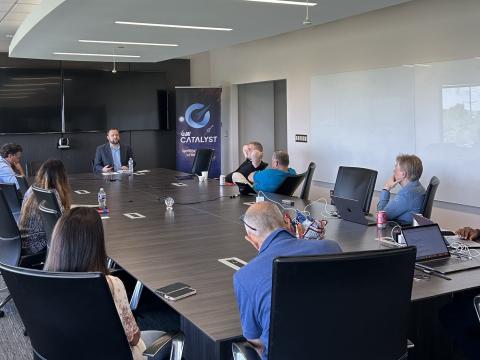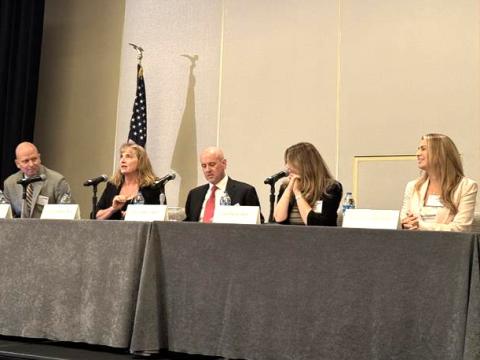Surviving the ‘Lost Generation’ of STEM Students
It’s not too late to redeem certain educational shortcomings that contributed to today's massive skilled-labor gap that leaves the United States ill positioned in the global competition for 21st-century high-tech jobs.
Delaying the introduction of science, technology, engineering and mathematics, commonly referred to as STEM, in elementary and middle schools has contributed to the plight of a hamstrung computer-savvy work force. Simultaneously, the national debate over unemployment and who will fill the surplus of coveted jobs in the future continues to grow. About 15 years ago, a focus on STEM didn't occur until many students reached high school or older. It's time to change that trend. SIGNAL Media and AFCEA International’s Women in AFCEA are addressing the issue in a multi-month project, with a particular focus on women in STEM.
It’s not too late to redeem certain educational shortcomings that contributed to today's massive skilled-labor gap that leaves the United States ill positioned in the global competition for 21st-century high-tech jobs.
The delay to entice young students early on in their schooling in math and sciences contributed to the plight of a hamstrung work force that fuels a growing portion of the unemployment national debate over who will fill the surplus of coveted jobs.
"There is this lost generation that didn't get STEM early enough," says Evetta-DiRee McGuire, a senior program manager at ManTech International Corporation, using the acronym for science, technology, engineering and mathematics. "The were already in high school, going into college, when the STEM focus happened. They already chose what they wanted to do for careers."
The shortage of trained high-tech workers—both men and women—in STEM fields is punctuated by the lack of women who remain in these critical fields, McGuire says. The U.S. Bureau of Labor Statistics projects that by 2020, 1.4 million computer-science-related jobs will be available but only 400,000-computer science graduates with the skills to apply for these jobs.
As clarity of the skill sets future employees will need emerges and the realization that the U.S. work force trails other nations sets in, government and businesses are bringing about slow but steady changes—from a reshaping of educational priorities to government policies to entice, train and retain women and minorities.
“I’d like to think, based on our educational system’s STEM focus, that a generation from now, all of these elementary school kids … will be in a much better place,” McGuire says.
But what can be done in the meantime?
One key to bridging the gap is training the current work force and enticing personnel with the proper aptitudes to switch careers, she offers. “There are people who have the skill sets, they were just never focused or trained in them because [the training] was never given to them as a focus.
“When I’m doing interviews, I don’t look for someone who necessarily has every degree in the right place and every certification that they need,” says McGuire, who oversees a staff of more than 100 personnel providing network and communications engineering and installation support for multiple U.S. and overseas U.S. Army field sites. “I look for the aptitude, for the ability and the skills and ask: What can I make you into?
“We have to be willing to accept the people who don't have the perfect resume, but have the drive and the willingness to fill these voids.”
During her career, she noted many corporations or management teams were unwilling to take that chance. “They were looking for that perfect fit, the person who was the top 10 percent of their class at this well-named school. That's not always what helps our industry.”
Sometimes it is a matter of opening employees’ eyes—and that of management—to something new. As a young woman and a high school student, McGuire figured she’d follow in the identical footsteps as the women in her family and become a teacher.
Three people in her life altered that course.
“My aunt, who was very influential in my life and was a teacher, came to me and said … ‘You're not going into teaching because I won't support you if you do that.’”
Joining her aunt in recognizing McGuire’s aptitude to excel in math and science were a high school mentor and a guidance counselor—both men—who steered her toward engineering. “At that point, as silly as it sounds, I did not know what an engineer even was. I thought they wanted me to drive a train!” she laughs.
But she was inspired by the chance to learn something new, something different, and so she heeded their advice.
She faced difficulties during her freshman year that nearly derailed her now-prominent career. “In college, I was one of two girls in a large engineering class. I was just trying to understand what it was, what engineering was about and how to apply what I knew,” she recalls. “I had a lot of questions. I was basically discouraged by the professors who said they didn't have the time … to answer me because I should have already understood [the basics]. I got a lot of that during my freshman year that left me feeling like I didn't belong.”
So she changed schools—and was again on track to becoming an engineer. “It's about opening people’s eyes to new concepts and new ways,” says McGuire, 51, who plans to teach after she retires.
Providing additional opportunities is one solution to growing the high-tech work force, she advises. Another is to dash the lingering stereotypes that continue to drive women to leave their STEM-related jobs. Despite years of warnings by educators and authorities that the gender gap will hamper U.S. competitiveness for technological dominance in the global high-tech market, women who opt to pursue STEM fields and are successful are more likely than men to quit.
Several efforts can stem the tide of women leaving, McGuire offers. “We need to redefine work/life balance from a woman's perspective,” she says. Women are more likely than men to take leave to care for a sick child, for example. Often, that absence translates into the belief that women value their work less than men do.
Additionally, the issue of the persistent pay gap for working women continues across the board. Women's earnings were 79 percent of men's in 2015, according to the U.S. Census Bureau, which based the statistics on the median salaries of all full-time workers. In addition, women in STEM-related fields often lag men in climbing the ladder of success, McGuire notes. “Everybody needs to feel some level of accomplishment. If there are not opportunities for that level of accomplishment, they will not stay.”
Joining various women- and minority-focused organizations, such as the Society of Women Engineers, Women in Defense and historically black colleges and universities (HBUCs), helps increase industry's interest for women and undergirds those women already there, McGuire adds. “This partnership would involve helping these organizations, financially and functionally, in their mission as well as looking to these organizations as a source for finding and growing key talent.”
Slowly, industry leaders are embracing that the problem goes beyond being a “women’s issue.” Instead, they are recognizing that recruiting and retaining women and minorities in the STEM fields are a societal issue. “Successful men in the STEM field want to continue to be successful, and the only way they can do that is to have the best of society working with them—and that includes women and minorities,” McGuire says.
Join AFCEA now, where for $50 a year, you can make a difference in the STEM community, for women, students and national security. Read about AFCEA’s programs for women in STEM.
Join us for AFCEA's first women's panel. "Why Are Women Leaving STEM?" begins at 1:30 p.m. on August 3 in the Engagement Theater at TechNet Augusta. The conversation continues during a networking reception immediately following the session courtesy of panel sponsors Walker and Associates and Ciena.

![Evetta-DiRee McGuire encountered a few obstacles in her early pursuit of an engineering degree—such as not knowing what the field entailed. “At that point, as silly as it sounds, I did not know what an engineer even was. I thought [mentors] wanted me to drive a train!”](/sites/default/files/styles/wide/public/media/images/migrated/CROPDiRee%2520014.jpg?itok=MDx3J3FQ)



Comments